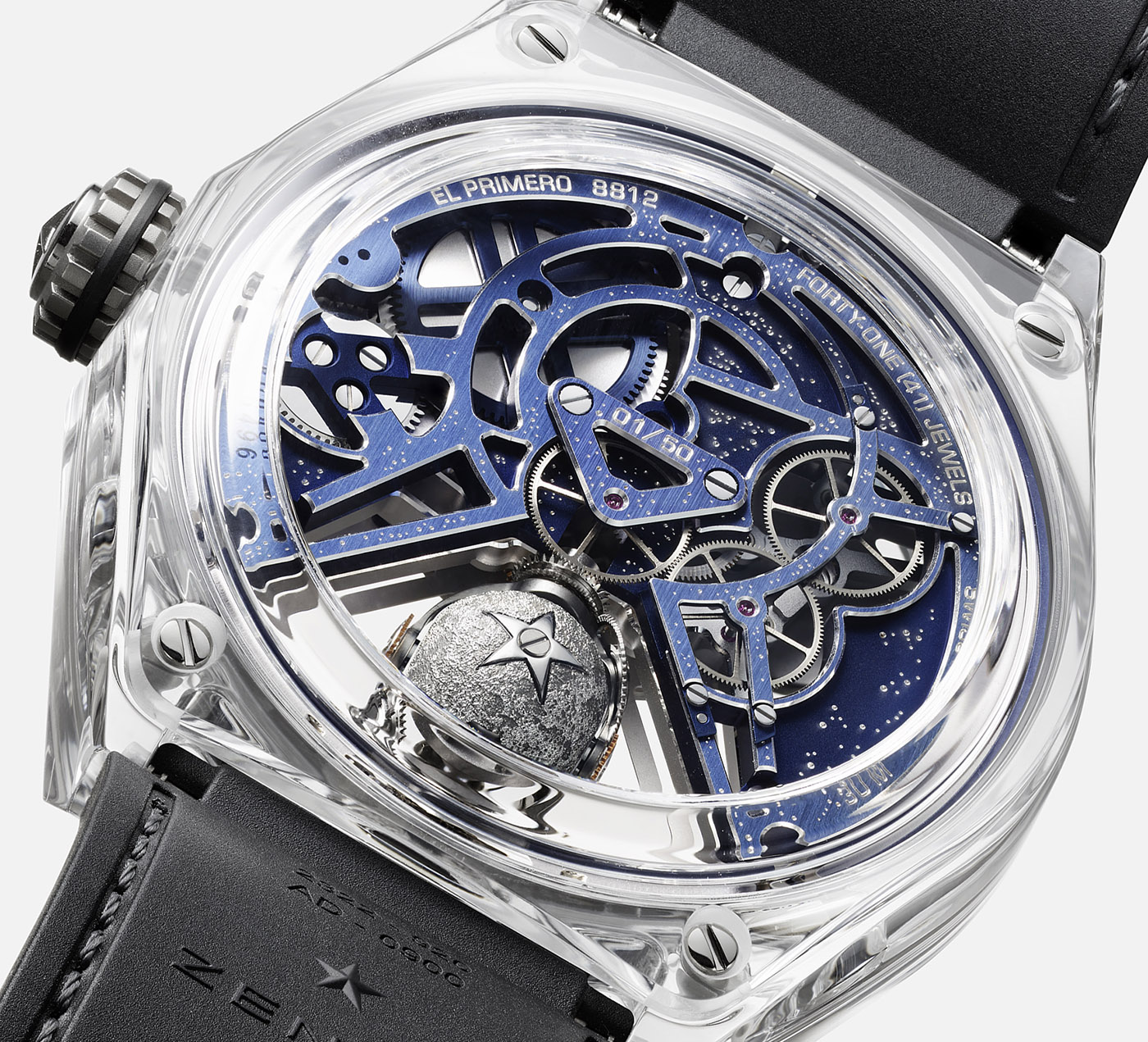
Although human beings are conditioned to the constant presence of gravity, its effects are a significant hurdle for mechanical watchmaking. The pull of gravity across a movement’s gear train as it sits in a static position eventually leads to slight inaccuracies, and over the centuries watch brands have devised intricate solutions to counteract gravity’s effects. While the more mobile nature of a wristwatch (as opposed to a pocket watch or clock) mitigates much of the static gravity problem, the traditional remedy for mechanical movements is the tourbillon escapement. By allowing the escapement to rotate around its axis, gravity’s pull is distributed more evenly across the movement and greater precision can be achieved. For its latest high-end releases, Zenith employs both this time-tested method of counteracting gravity as well as a more novel gyroscopic stabilizer device. By embracing both the present and future of gravity compensation, the limited edition Zenith Defy Zero G Sapphire and the Zenith Defy 21 Double-Tourbillon Sapphire shine a dramatic spotlight on the brand’s horological capability.
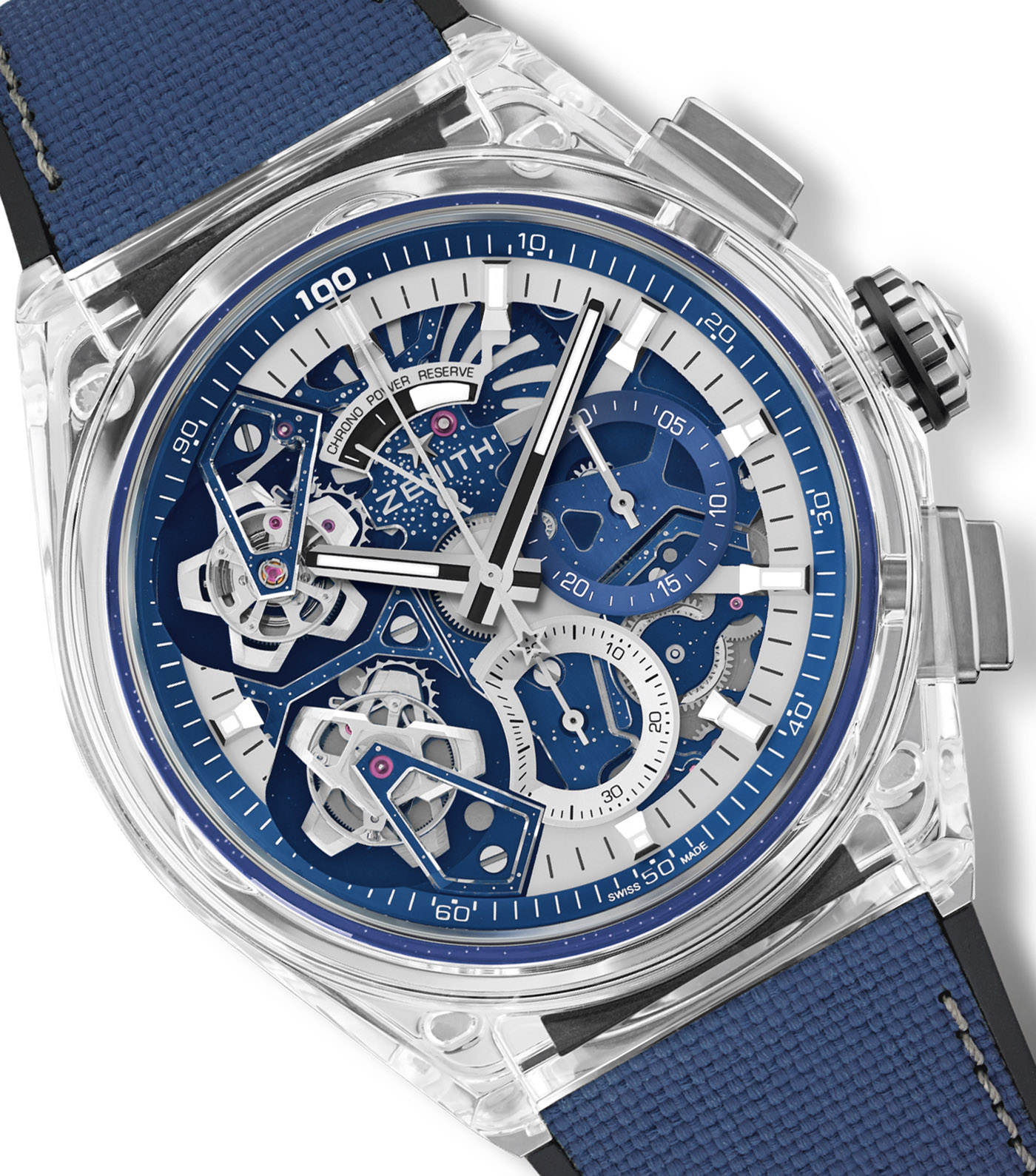
Both the Zenith Defy Zero G Sapphire and the Defy 21 Double Tourbillon Sapphire share a full sapphire case design measuring in at 46mm-wide. The sharply faceted, planar form is shared with the rest of the Defy 21 series, but its sapphire material helps to emphasize the futuristic and sporty character of the design in images. While many case designs fall into disarray when rendered in sapphire, the narrow bezel, tapering case side chamfer, and flat semi-hooded lugs all remain sharply defined in these iterations. While these clear cases do give an uninterrupted view of the complex movements within, they do suffer on the durability front in comparison to their regular production cousins. Both the Defy Zero G Sapphire and the Defy 21 Double- Tourbillon Sapphire manage only a disappointing 30 meters of water resistance.
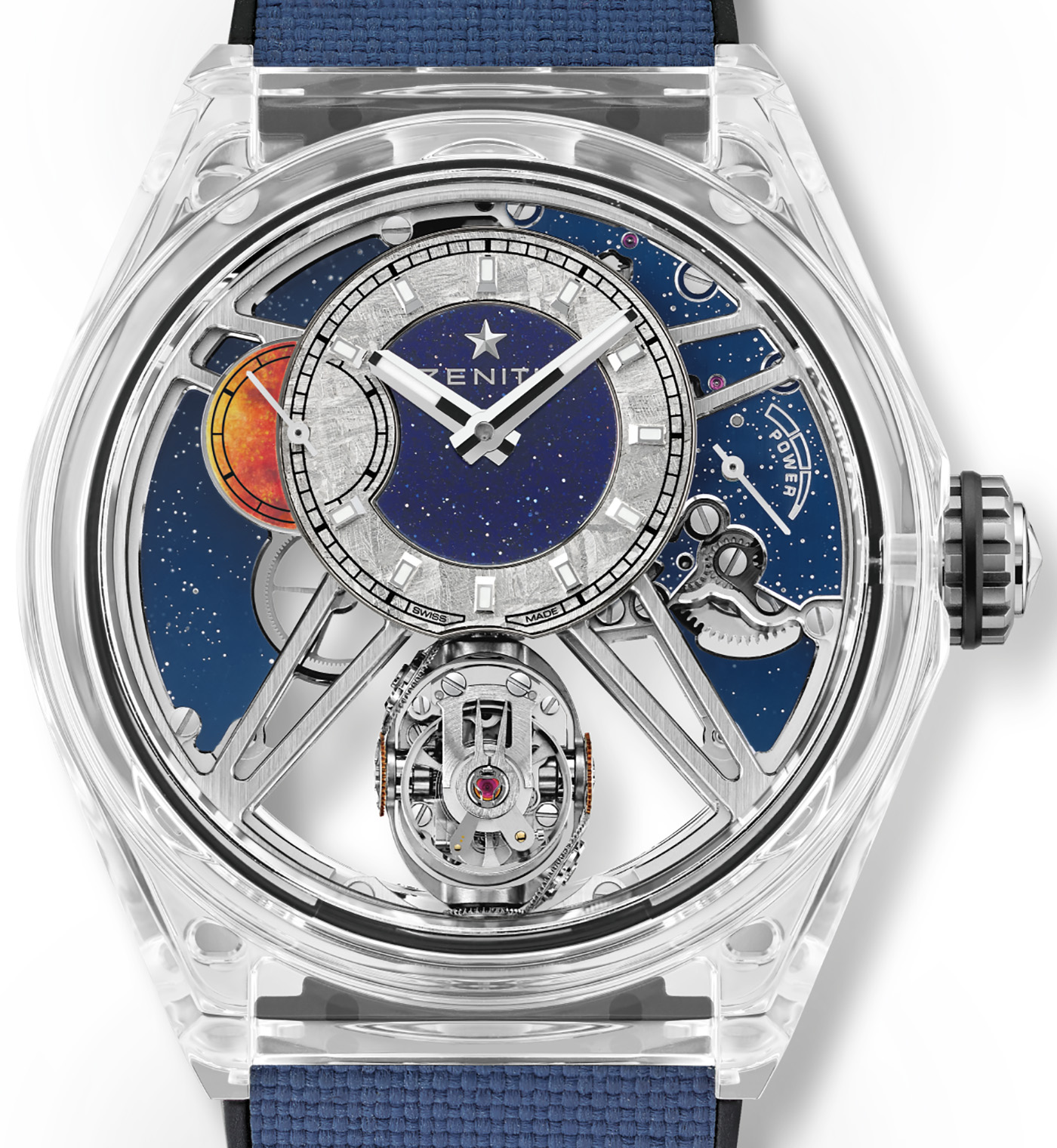
Although the dials of both the Zenith Defy Zero G Sapphire and the Defy 21 Double Tourbillon Sapphire are ornate skeleton showcases of the brand’s movement-making prowess, each model takes a markedly different approach. The Defy Zero G Sapphire is the cleaner design of the pair, with an open and airy layout that makes the most of the case’s wide diameter to create dramatic negative space. Although the layout may be simple compared to its counterpart, the execution is anything but, with materials and finishes ranging from exposed meteorite to aventurine glass, miniature painting, engraved midnight blue PVD, and brushed stainless steel for the skeleton bridges. Timekeeping is relegated to the 12 o’clock subdial, which combines a space-inspired deep blue aventurine central section with a bright exposed meteorite outer ring. The striped baton handset and applied rectangular indices give this cosmic combination an injection of Zenith’s brand DNA, but the design is coupled to a curiously traditional chemin-de-fer minutes track. The 10 o’clock running seconds subdial is split between the meteorite ring and a mottled orange section, hand-finished by an expert miniature painter to evoke the look of the planet Mars. Zenith’s use of engraved navy blue PVD continues the starfield effect across the majority of the dial in images, but stops short to draw the eye towards the Defy Zero G Sapphire’s signature element — its 6 o’clock gyroscopic module. Rather than rotate the escapement across its axis like a tourbillon does, this unique design instead uses a miniaturized gyroscope to keep the escapement assembly level regardless of the position of the watch. This will likely produce an eye-catching spectacle on the wrist, and even in images, the complex cage surrounding the balance wheel is visually impressive.
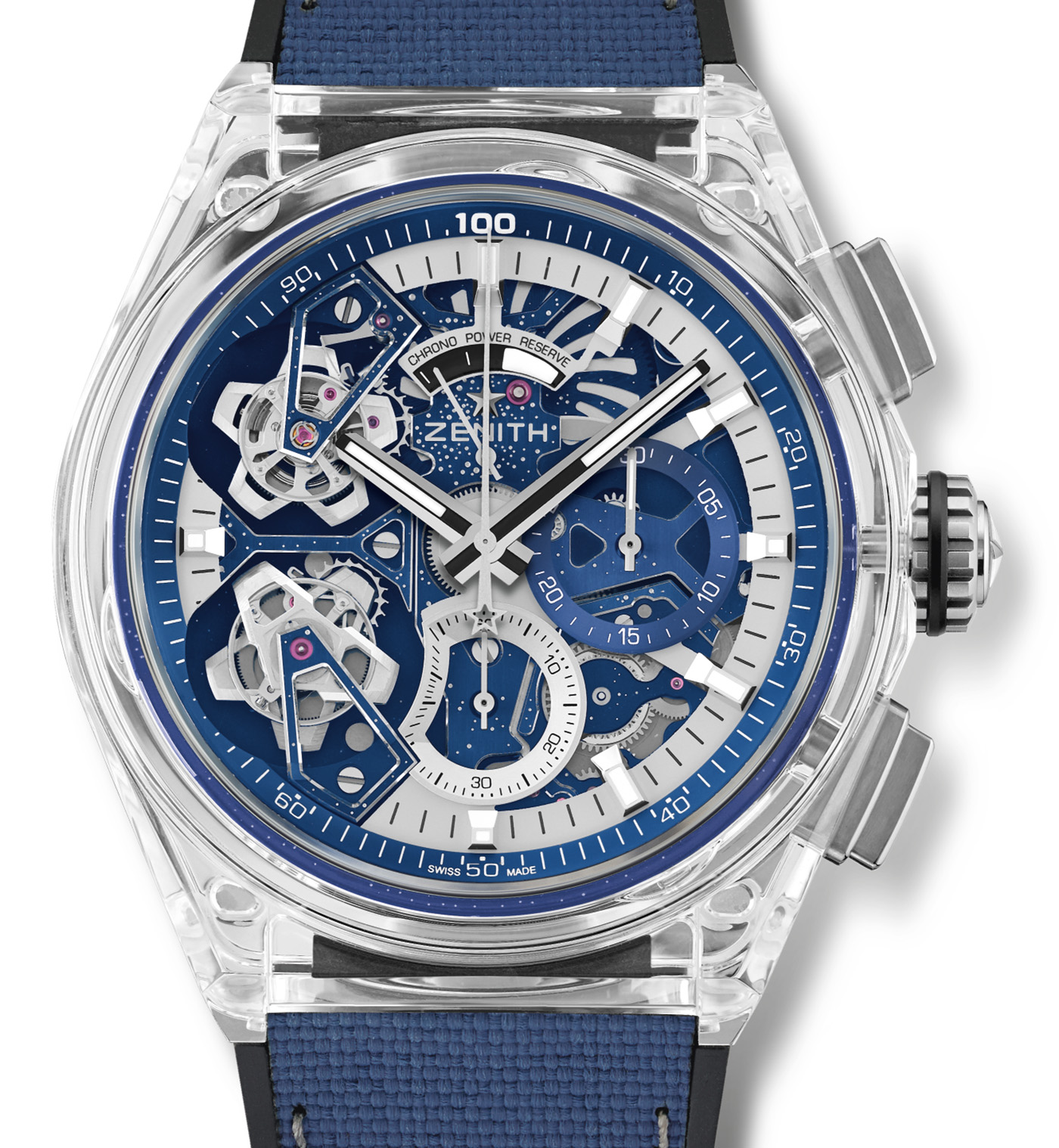
Zenith enthusiasts should feel a bit more familiar with the dial layout of the Defy 21 Double Tourbillon Sapphire, as it follows the layout of the Zenith x Felipe Defy Double Tourbillon created for Only Watch 2021. The complex skeleton design separates itself into three distinct visual layers, each of which is color-coded for easier legibility in images. The top layer of skeleton bridges and the 3 o’clock chronograph minutes subdial are rendered in engraved blue PVD, with a random star pattern that plays off the design’s zero-gravity inspiration. For lower-level bridges, the minutes track, the 12 o’clock power reserve indicator, and the 6 o’clock chronograph seconds subdial, the brand opts for a contrasting grainy silver tone, while the solid bridges that form the bottom layer are finished in pure midnight blue PVD, allowing them to fade smoothly into the background. The outer decimal scale is an immediate visual clue to the Defy 21 Double Tourbillon Sapphire’s signature feature, a blindingly fast 1/100-second central chronograph hand that completes a circuit of the dial once per second. When this unique chronograph element is not in motion the pair of skeletonized tourbillons at 8 o’clock and 10 o’clock dominate the scene. One of these tourbillons works as the escapement for the base movement, completing a full rotation once every 60 seconds at a 36,000 bph beat rate and functioning as a running seconds indicator. When the chronograph is engaged, the second tourbillon springs into action, vibrating at an immensely fast 360,000 bph frequency and rotating once every five seconds. This sense of speed, coupled with the sheer presence of a pair of tourbillons, should make for a spectacular display on the wrist.

Zenith powers the Defy Zero G Sapphire with its in-house El Primero 8812 S hand-wound skeleton movement. When viewed from the caseback side, the El Primero 8812 S contrasts the dial side’s open simplicity with a raised geometric web of engraved blue PVD skeleton bridges and rhodium-plated gear train elements. As with the dial side, however, the gyroscopic module takes center stage in images. For the reverse side of this intricate device, Zenith uses a hemispherical counterweight in hand-engraved platinum, finished with ornate craters to evoke the surface of the moon and topped with the brand’s star emblem. In terms of performance, the El Primero 8812 S offers a solid 50-hour power reserve at a smooth 36,000 bph beat rate. For the Defy 21 Double Tourbillon Sapphire, the brand instead turns to its in-house El Primero 9020 automatic tourbillon chronograph movement. While the dial side uses a layered bridge structure and its show-stopping double tourbillons, the caseback side of the El Primero 9020 offers a comparatively simpler view. Broad engraved blue PVD bridges cut away to reveal elements of the gear train, but the matching oversized star-shaped rotor covers much of the visual real estate in images. When the torque-hungry ultra-high-frequency chronograph and its attached tourbillon are not in use, the El Primero 9020 provides a 50 hour power reserve at the El Primero’s signature 36,000 bph beat rate, along with COSC certified chronometer grade accuracy. Both the Zenith Defy Zero G Sapphire and the Defy 21 Double Tourbillon Sapphire are paired with navy blue Cordura-effect textured rubber straps, with black lining for a pop of contrast. As an added bonus, buyers of either design are invited to an exclusive zero-gravity parabolic flight with Novespace, a subsidiary of the French National Space Center. The flight is currently scheduled to take place in Bordeaux, France in February 2022, although the brand makes no mention of travel accommodations.
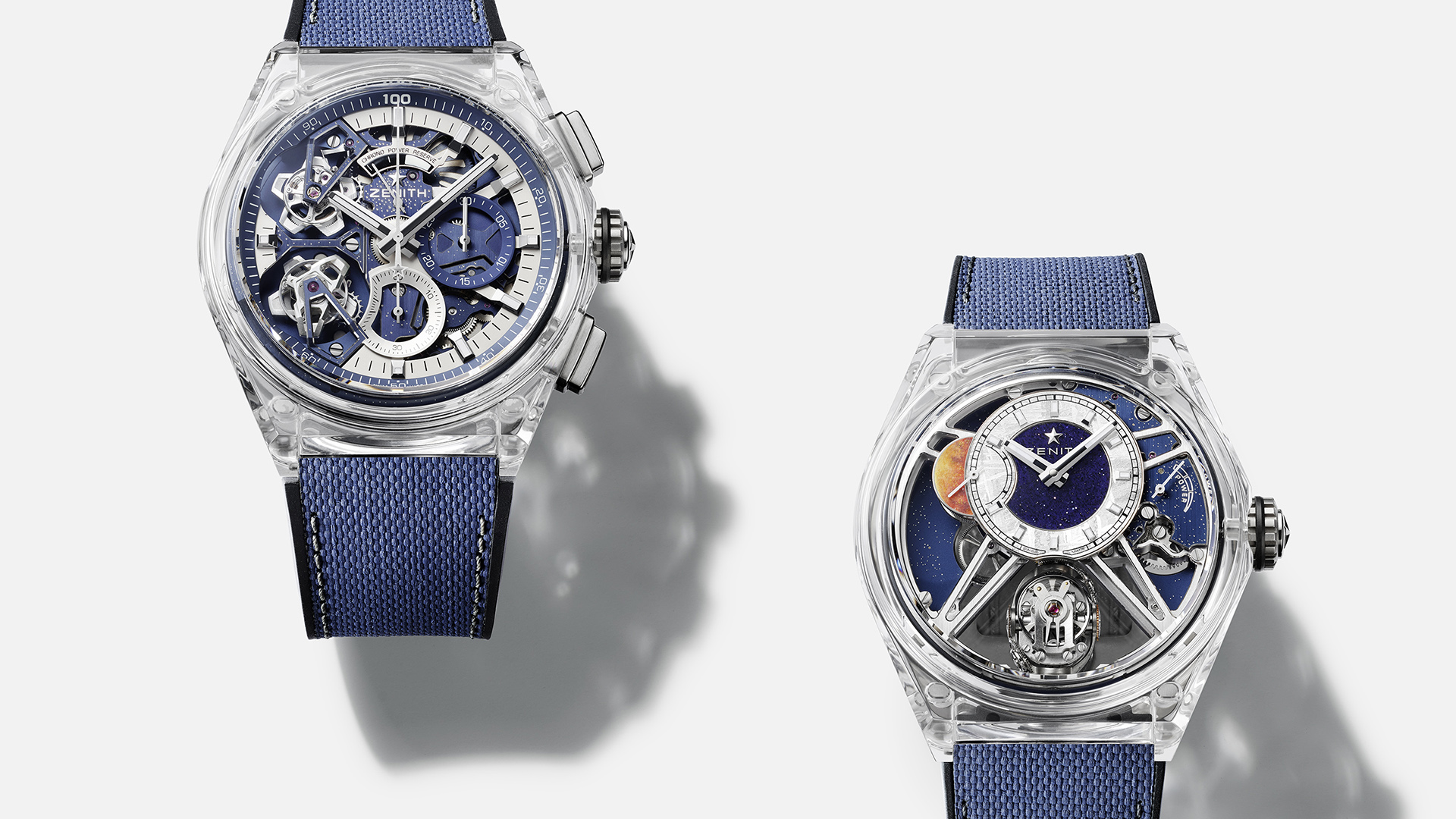
With two entirely different but equally spectacular methods of counteracting gravity, the limited edition Zenith Defy Zero G Sapphire and the Zenith Defy 21 Double Tourbillon Sapphire both offer attention-grabbing demonstrations of the marque’s considerable haute horlogerie expertise. Both the Defy Zero G Sapphire and the Defy 21 Double Tourbillon Sapphire are limited to 10 examples each. The Zenith Defy Zero G Sapphire and the Zenith Defy 21 Double Tourbillon Sapphire are available now through authorized dealers, with MSRPs of $159,700 and $180,300, respectively. For more details, please visit the brand’s website.
